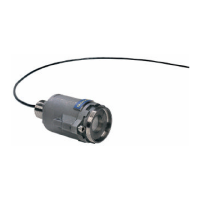36
X
X
I
I
.
.
A
A
P
P
P
P
E
E
N
N
D
D
I
I
C
C
E
E
S
S
Appendix 1
The measuring cell is positioned facing downwards. The physical location of the TRANSMITTER
depends on the type of gas to be detected:
• at the high point if the gas is lighter than air,
• at the low point if the gas is heavier than air,
• near outlet vents in the case of mechanical ventilation,
• or, more generally, in locations where the gas is likely to accumulate.
Despite its high degree of protection (IP66), it may be necessary to protect the TRANSMITTER
against adverse weather conditions (rain, dust, direct sunlight, etc.) and from direct spraying with
cleaning or maintenance products (causing soiling of the detection cell).
The TRANSMITTER must also be positioned so as to allow access to the measuring cell so that it
can be replaced.
Detectors must be positioned so as to optimize the detection of accumulations of gas emitted in the
air.
Factors to be considered in determining optimal detector positioning:
⇒ potential sources of gas and vapour emissions
⇒ chemical and physical data on gases and vapours which may be present
⇒ liquids with low volatility ⇒ detectors as near as possible to the leak risk area
⇒ type and concentration of gas leaks (high-pressure jet, slow leak, etc.)
⇒ air movements
- indoors: natural and mechanical ventilation
- outdoors: wind speed and direction
⇒ effect of temperature
⇒ installation so as to avoid mechanical damage or deterioration caused by water in summer
⇒ positioning to allow easy maintenance, if possible
⇒ avoiding direct sunlight on the readout area as this would lead to maintenance problems

